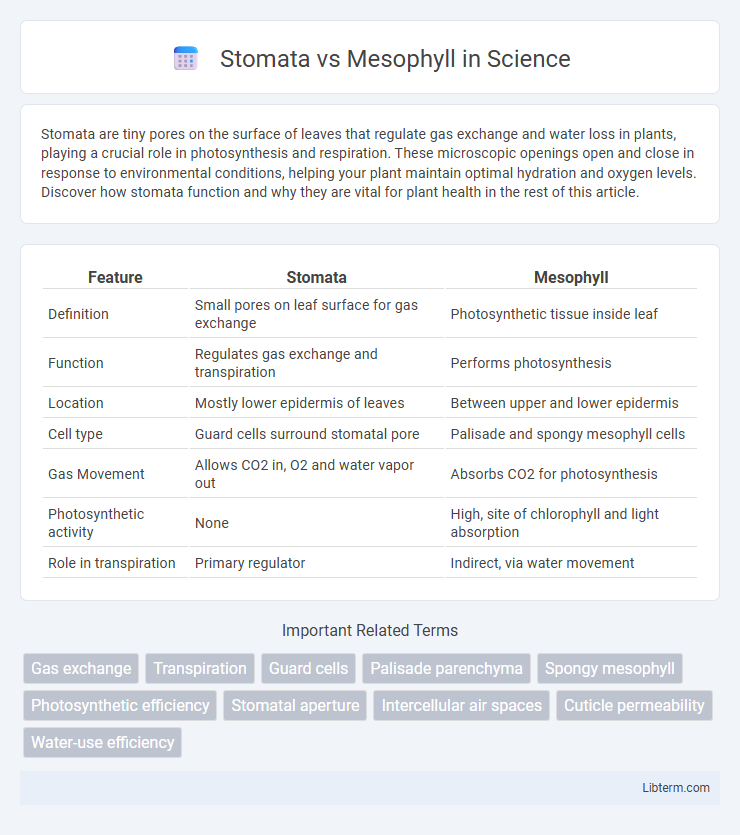Stomata are tiny pores on the surface of leaves that regulate gas exchange and water loss in plants, playing a crucial role in photosynthesis and respiration. These microscopic openings open and close in response to environmental conditions, helping your plant maintain optimal hydration and oxygen levels. Discover how stomata function and why they are vital for plant health in the rest of this article.
Table of Comparison
| Feature | Stomata | Mesophyll |
|---|---|---|
| Definition | Small pores on leaf surface for gas exchange | Photosynthetic tissue inside leaf |
| Function | Regulates gas exchange and transpiration | Performs photosynthesis |
| Location | Mostly lower epidermis of leaves | Between upper and lower epidermis |
| Cell type | Guard cells surround stomatal pore | Palisade and spongy mesophyll cells |
| Gas Movement | Allows CO2 in, O2 and water vapor out | Absorbs CO2 for photosynthesis |
| Photosynthetic activity | None | High, site of chlorophyll and light absorption |
| Role in transpiration | Primary regulator | Indirect, via water movement |
Introduction to Stomata and Mesophyll
Stomata are microscopic pores primarily located on the leaf surface, facilitating gas exchange by allowing carbon dioxide entry and oxygen release while minimizing water loss through transpiration. Mesophyll tissue, located beneath the epidermis, consists of palisade and spongy cells responsible for photosynthesis due to their high chloroplast concentration. The functional interplay between stomata and mesophyll cells optimizes photosynthetic efficiency and water regulation within plants.
Structural Differences Between Stomata and Mesophyll
Stomata are microscopic pores typically found on the epidermis of leaves, composed of two specialized guard cells that regulate gas exchange and water vapor release. In contrast, mesophyll cells form the inner tissue of the leaf, primarily responsible for photosynthesis, with chloroplast-rich palisade and spongy layers. The structural difference highlights stomata as dynamic openings controlled by guard cells, while mesophyll consists of densely packed cells optimized for light absorption and gas diffusion.
Location of Stomata vs Mesophyll in Plant Tissues
Stomata are primarily located on the epidermis of leaves, especially the lower surface in dicots, facilitating efficient gas exchange with the environment. Mesophyll tissue resides beneath the epidermis and is divided into palisade mesophyll, which is dense and located just below the upper epidermis for optimal light absorption, and spongy mesophyll, found closer to the lower epidermis, characterized by air spaces to promote gas diffusion. This spatial arrangement ensures stomata regulate gas entry and exit while mesophyll cells optimize photosynthesis.
Primary Functions of Stomata
Stomata primarily regulate gas exchange by controlling the uptake of carbon dioxide and the release of oxygen during photosynthesis while minimizing water loss through transpiration. These microscopic pores on the leaf surface open and close in response to environmental conditions, balancing photosynthetic efficiency and water conservation. Mesophyll cells, in contrast, are mainly responsible for housing the chloroplasts where photosynthesis occurs, facilitating the conversion of light energy into chemical energy.
Core Roles of Mesophyll Cells
Mesophyll cells primarily facilitate photosynthesis by housing chloroplasts where light energy is converted into chemical energy, a process essential for plant growth. Stomata regulate gas exchange and transpiration, enabling CO2 uptake that mesophyll cells utilize during carbon fixation in photosynthesis. The efficiency of mesophyll cells in capturing light and exchanging gases with stomata directly influences plant productivity and water use efficiency.
Gas Exchange: Stomata vs Mesophyll Mechanisms
Stomata regulate gas exchange by opening and closing to control the diffusion of carbon dioxide into the leaf and oxygen out of the leaf, thus optimizing photosynthesis and transpiration rates. Mesophyll cells facilitate internal gas exchange by providing a large surface area with intercellular air spaces that allow efficient diffusion of gases to chloroplasts for photosynthesis. The coordination between stomatal aperture and mesophyll gas diffusion ensures optimal carbon dioxide uptake while minimizing water loss in plants.
Water Regulation and Transpiration
Stomata are specialized pores on leaf surfaces that regulate water loss by controlling gas exchange during transpiration, balancing water conservation with CO2 intake for photosynthesis. Mesophyll cells, located beneath the epidermis, facilitate gas diffusion and house chloroplasts for photosynthesis, indirectly influencing transpiration through internal water vapor pressure. Efficient stomatal regulation minimizes excessive water loss, while mesophyll structure affects the internal humidity gradient, optimizing overall water use in plants.
Photosynthesis: Contributions of Stomata and Mesophyll
Stomata regulate gas exchange by controlling the intake of carbon dioxide and release of oxygen, directly influencing photosynthesis efficiency. Mesophyll cells house chloroplasts, where the light-dependent and light-independent reactions convert CO2 and water into glucose and oxygen. The coordination between stomatal opening and mesophyll activity maximizes carbon fixation while minimizing water loss during photosynthesis.
Adaptations in Various Plant Species
Stomata are specialized pores on leaf surfaces that regulate gas exchange and water loss, adapting in density and size to environmental conditions such as drought or high humidity across plant species. Mesophyll cells, located within the leaf, vary in structure--palisade mesophyll is densely packed for maximum photosynthesis efficiency in sun-exposed plants, while spongy mesophyll has air spaces facilitating gas diffusion in shade-tolerant species. These adaptations in stomatal distribution and mesophyll anatomy enable plants to optimize photosynthesis and water use efficiency in diverse habitats ranging from arid deserts to humid forests.
Stomata and Mesophyll in Plant Physiology Research
Stomata are microscopic pores on plant leaves and stems essential for gas exchange, facilitating the uptake of carbon dioxide and release of oxygen and water vapor. Mesophyll, comprising palisade and spongy cells, is the primary site of photosynthesis, containing chloroplasts that convert light energy into chemical energy. Plant physiology research focuses on the dynamic interaction between stomatal regulation and mesophyll photosynthetic efficiency to understand plant responses to environmental stress and optimize water use efficiency.
Stomata Infographic

 libterm.com
libterm.com